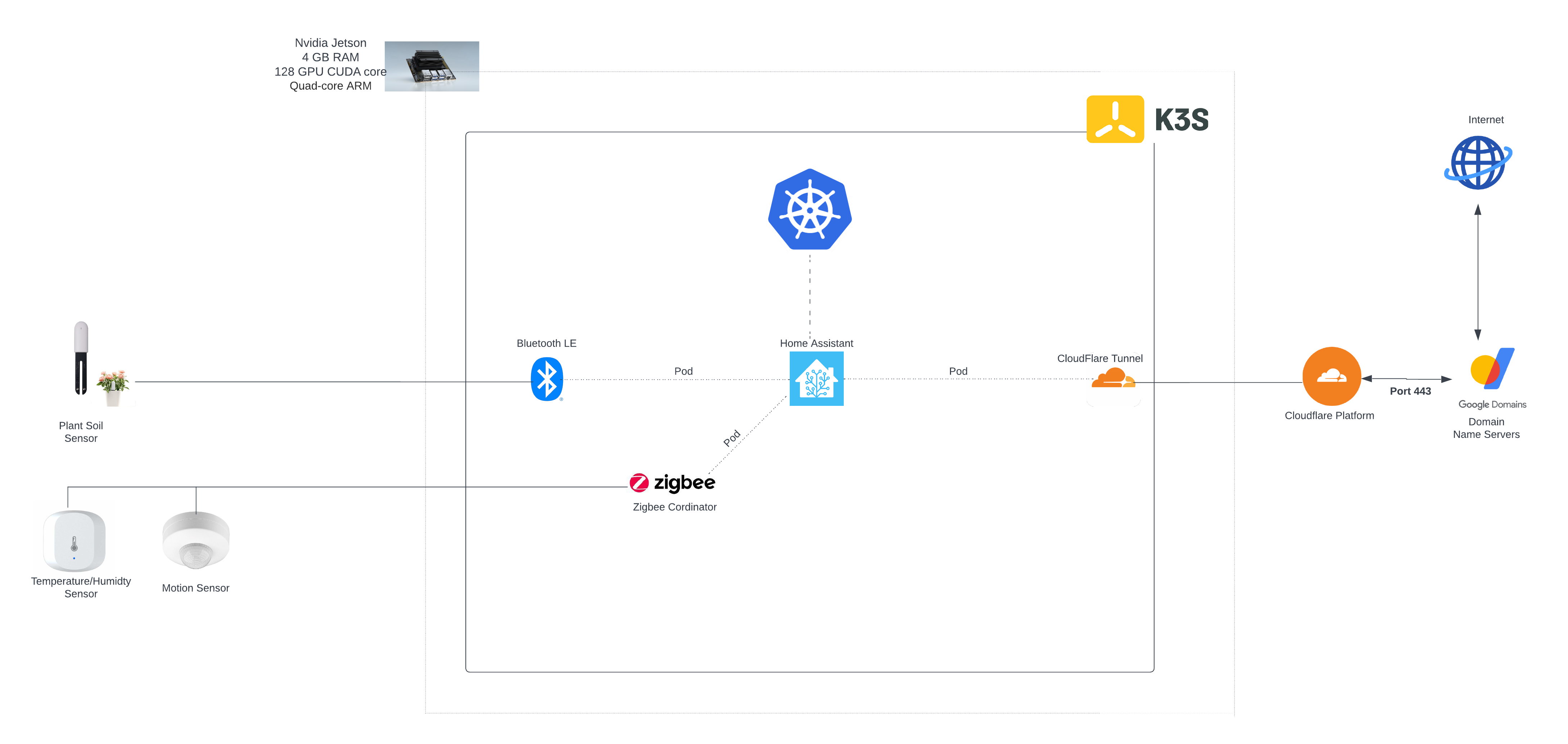Personal project to run home-assistant on K3s locally on Nvidia Jetson(ARM64)
Complete walkthrough on the setup is posted on Medium
In this setup, a K3s cluster is being run on a single ARM64 NVidia Jetson Nano device, showcasing the power of containerization technology. One of the pods in this cluster is home-assistant, utilizing the official container image. There are other pods running in the same namespace, such as bluez service, which interfaces with Bluetooth hardware, and a zigbee coordinator service, which interfaces with zigbee hardware, both connected to the Nvidia Jetson using USB ports.
The bluez service pod is capable of fetching messages sent by a Plant soil sensor via Bluetooth Low Energy (BLE). Additionally, the zigbee device sensor data is sent to the zigbee coordinator. These devices are easily mapped to Homeassistant using built-in add-ons that are both available and supported.
To make this setup accessible from outside the network, a Cloudflare tunnel service is running inside the cluster. This allows Home-assistant to be reachable from the outside world. To ensure proper name resolution, Cloudflare name server details from Google Domain Servers are injected into the system, making it easy to access via domain names. Overall, this is a powerful and well-connected system, showcasing the potential of containerization technology for running complex setups on single devices.
curl -sfL https://get.k3s.io | INSTALL_K3S_EXEC="server --disable servicelb --disable traefik --write-kubeconfig-mode 644 --cluster-cidr=10.10.0.0/16" INSTALL_K3S_VERSION="v1.26.3+k3s1" sh -s -
For tapping GPU capabilities in K3s cluster, it needs to follow a few steps
kubectl create -f https://raw.githubusercontent.com/NVIDIA/k8s-device-plugin/v0.10.0/nvidia-device-plugin.yml
The below will create a deployment with running cloudflare daemon to connect t to cloudflare platform, allowing access to the your internally hosted pods
kubectl create -f ./cloudflare-daemon/deployment.yaml
Instll MetalLB
--------------
kubectl apply -f https://raw.githubusercontent.com/metallb/metallb/v0.9.3/manifests/namespace.yaml
kubectl apply -f https://raw.githubusercontent.com/metallb/metallb/v0.9.3/manifests/metallb.yaml
# Create a secret for encrypted speaker communications
$ kubectl create secret generic -n metallb-system memberlist --from-literal=secretkey="$(openssl rand -base64 128)"
Config for metallb
------------------
apiVersion: v1
kind: ConfigMap
metadata:
namespace: metallb-system
name: config
data:
config: |
address-pools:
- name: address-pool-1
protocol: layer2
addresses:
- 192.168.2.128/25
helm repo add jetstack https://charts.jetstack.io
helm repo update
helm install cert-manager jetstack/cert-manager --namespace cert-manager --create-namespace --set installCRDs=true
- First we need to make sure that both the control plane and worker nodes are able to communicate with each other. To solve this issue, I have made use of tailscale VPN which will install agents on the ARM64 devices. Tailscale features free connectivity upto 3 nodes
curl -fsSL https://tailscale.com/install.sh | sh
- In the worker nodes, use the below code snippet
TOKEN="get token from the control server"
curl -sfL https://get.k3s.io | INSTALL_K3S_EXEC="agent" INSTALL_K3S_VERSION="v1.26.3+k3s1" K3S_URL=http://[ipfromtailscale]:6443 K3S_TOKEN=$TOKEN sh -s - --snapshotter=native
